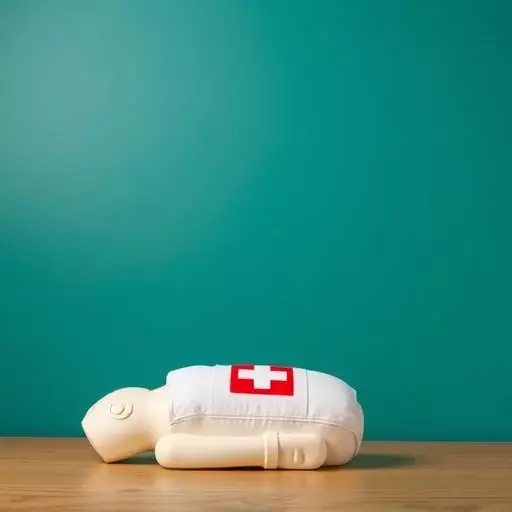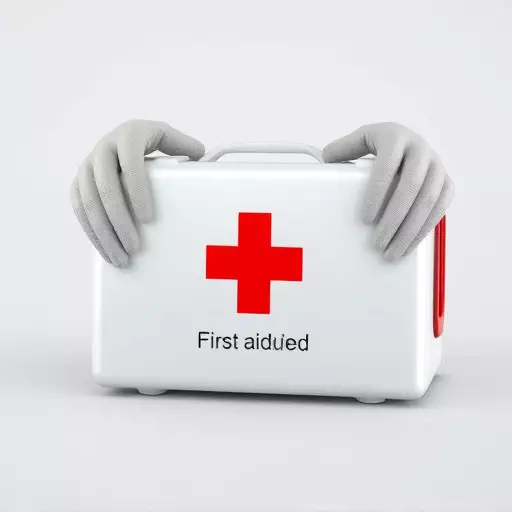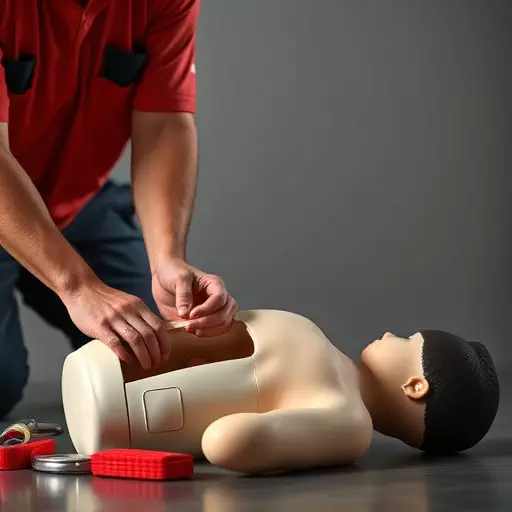Basic Life Support (BLS) training is a vital program that covers first aid and CPR certification, equipping individuals with the essential skills to respond to life-threatening emergencies such as sudden cardiac arrest. This comprehensive training includes recognizing signs of distress, managing airways, performing quality CPR, administering rescue breaths, and using an Automated External Defibrillator (AED) effectively. The practical sessions are designed to simulate real-life scenarios, allowing learners to practice these techniques in a controlled environment. Regular updates to BLS training are crucial due to the rapid advancements in medical protocols and technologies. First aid certification obtained through this training not only boosts confidence but also enhances the ability to increase survival rates by effectively employing an AED. It is emphasized that maintaining up-to-date first aid and CPR skills, as well as adhering to the latest certification requirements, is key to being prepared for emergencies and improving patient outcomes in critical situations where every second counts. Regular recertification courses are recommended to ensure proficiency with current BLS guidelines and AED operation protocols.
In emergency situations where every second counts, the swift deployment of an Automated External Defibrillator (AED) can be a matter of life or death. This article delves into mastering first aid and CPR training pivotal for AED usage, offering readers a comprehensive guide to confidently handle sudden cardiac arrests. We explore the fundamental aspects of Basic Life Support (BLS) training, which is indispensable in enhancing proficiency with AEDs. Additionally, we navigate through first aid certification requirements essential to ensure proper AED utilization. With practical steps laid out for effective AED application in critical situations, individuals can be prepared to intervene decisively when every moment makes a difference.
- Mastering First Aid and CPR Training for AED Usage: A Comprehensive Guide
- Understanding the Basics of Basic Life Support (BLS) Training and Its Role in AED Proficiency
- Navigating First Aid Certification Requirements to Ensure Proper AED Utilization
- Practical Steps for Effective AED Application in Emergency Situations: A Step-by-Step Approach
Mastering First Aid and CPR Training for AED Usage: A Comprehensive Guide

Mastering First Aid and CPR Training for AED Usage is a critical component in emergency response scenarios. The American Heart Association (AHA) recommends that individuals take comprehensive first aid and CPR training courses to gain proficiency in basic life support (BLS). These courses are designed not only to teach the theoretical aspects of BLS but also to provide hands-on practice with AEDs. Understanding how to quickly identify when defibrillation is needed, properly prepare the patient for shock delivery, and effectively use an AED can significantly increase the survival rates of sudden cardiac arrest (SCA) victims.
First aid certification requirements vary depending on local regulations and the organization providing the training, such as the AHA or the Red Cross. Typically, these programs require participants to complete a series of lectures, demonstrations, and practical exercises that cover various emergency situations. The training ensures individuals can confidently administer BLS, including the use of an AED, until advanced medical care is available. It’s crucial for anyone interested in being prepared for emergencies—be it family members, healthcare workers, or community volunteers—to pursue first aid and CPR certification with a focus on AED proficiency. This not only equips them with the necessary skills but also instills the confidence to act decisively in critical situations.
Understanding the Basics of Basic Life Support (BLS) Training and Its Role in AED Proficiency

Basic Life Support (BLS) training is an indispensable foundation for anyone looking to gain proficiency in using an Automated External Defibrillator (AED). BLS encompasses a range of life-saving techniques, primarily cardiopulmonary resuscitation (CPR) and the use of an AED. The training, which aligns with first aid and CPR certification requirements, equips individuals with the skills necessary to respond effectively to cardiac arrest. It covers recognizing the signs of life-threatening conditions, maintaining an unobstructed airway, delivering effective chest compressions, providing rescue breaths, and understanding how and when to employ an AED. This hands-on training often includes scenarios that simulate real-life emergencies, allowing trainees to practice their skills in a controlled environment. By obtaining first aid certification, individuals become confident and prepared to respond to medical emergencies, thereby enhancing their ability to use an AED effectively and increase the chances of survival for victims of sudden cardiac arrest. Regularly updating one’s BLS and AED training ensures that rescuers are well-versed in the latest protocols and techniques, which is crucial given the rapid advancements in medical practices and technologies.
Navigating First Aid Certification Requirements to Ensure Proper AED Utilization

To effectively utilize an Automated External Defibrillator (AED) in emergencies, it is imperative for individuals to have comprehensive first aid and cardiopulmonary resuscitation (CPR) training. Proper certification is a cornerstone of this preparation, ensuring that responders can confidently apply the necessary skills during critical situations. The first aid and CPR training courses are designed to equip individuals with the essential knowledge and practical abilities required for basic life support (BLS) interventions. These courses often cover the recognition of cardiac arrest, the steps for initiating BLS, and the correct procedures for AED usage. First aid certification requirements vary by region and may include both theoretical understanding and competency in hands-on demonstrations. Adhering to these standards ensures that individuals are not only certified but also adept at responding effectively when every second counts. It is crucial for those responsible for maintaining AEDs within public or workplace environments to stay informed about the latest first aid certification requirements, as they can change over time. By prioritizing up-to-date training and certification, communities can enhance their preparedness for emergencies and improve the chances of a successful resuscitation effort with an AED. Regularly scheduled recertification courses are vital to maintain proficiency and ensure that all certified individuals remain current with the latest BLS guidelines and AED operation protocols.
Practical Steps for Effective AED Application in Emergency Situations: A Step-by-Step Approach

In emergency situations where a person suffers from sudden cardiac arrest (SCA), prompt and effective utilization of an Automated External Defibrillator (AED) can significantly enhance survival rates. The first step in this critical process is to ensure that individuals are equipped with first aid and CPR training, as understanding the fundamentals of basic life support (BLS) is crucial for initial response. According to the American Heart Association, individuals should be familiar with the first aid certification requirements, which mandate hands-on practice and periodic renewal to maintain proficiency. Upon encountering a victim of SCA, the first responder must swiftly retrieve the AED from its accessible location, open the foil lid to expose the pads, and turn on the device following the manufacturer’s instructions. The AED will then analyze the heart’s rhythm and advise whether an shock is needed. If so, one pad is placed on the victim’s chest and the other on the back, ensuring good contact. The AED guides the user through each step, from initial assessments to delivering shocks. It is imperative that the AED is applied correctly and as quickly as possible because every minute without defibrillation decreases the victim’s chances of survival. Therefore, first aid and CPR training with a focus on BLS certification is not just a set of guidelines but a lifesaving skill that can be the difference between tragedy and recovery for SCA victims. Regular training and staying updated with the latest first aid certification requirements are vital in maintaining readiness to act in such critical situations.


